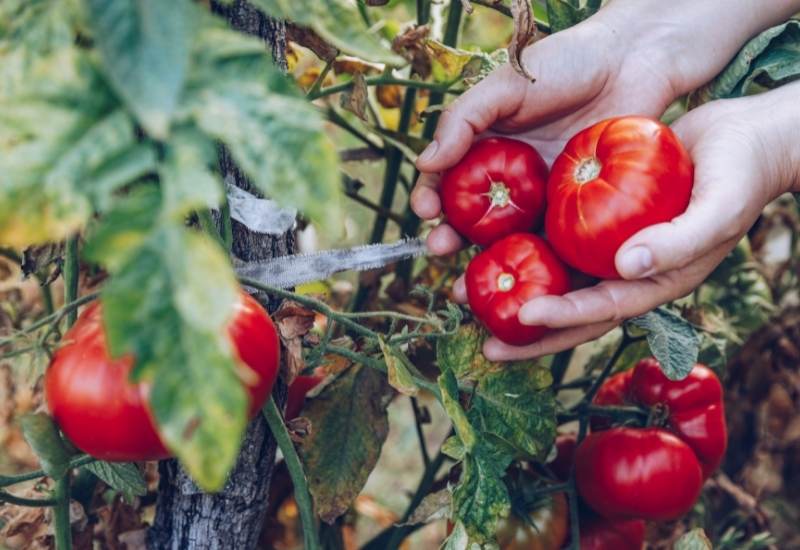
Tomatoes are one of the most anticipated harvests of the season, and homegrown tomatoes taste like no other with their colorful fruits exploding with flavor.
When it comes to harvesting them, any seasoned tomato grower will have their own two cents to chip in, with special techniques and tools that make their tomatoes rise above the rest.
Given that there are over 10,000 varieties of tomatoes you can grow, you can imagine the subtle differences that affect harvesting, so when exactly should you pick tomatoes?
Generally, tomatoes should be harvested once they are fully ripe, but there are some exceptions. When tomatoes are ripe their color (as specified on the seed packet) should deepen evenly around the fruit, their skin should develop a shine, they should smell fragrant, feel tender, and they should come off the vine with a delicate tug. The best way to tell if your fruits are ripe and ready to be picked is to taste one and let your tastebuds tell you!
As you can see, there are quite a few categories to check before harvesting your tomatoes.
Since every variety will have its own unique texture, color, pattern, and taste, it is a good idea to delve deeper into each of these categories and their exceptions to better understand the harvest time for tomatoes.
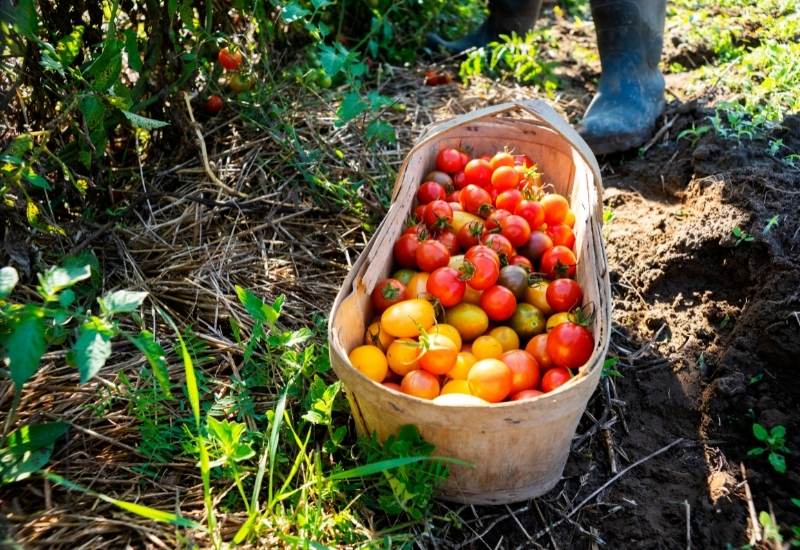
How long does it take to grow a tomato?
Your seed packet should tell you exactly how many days until harvest, or if you purchased seedlings from a plant nursery, there should be a tag telling you how many days from planting to harvest.
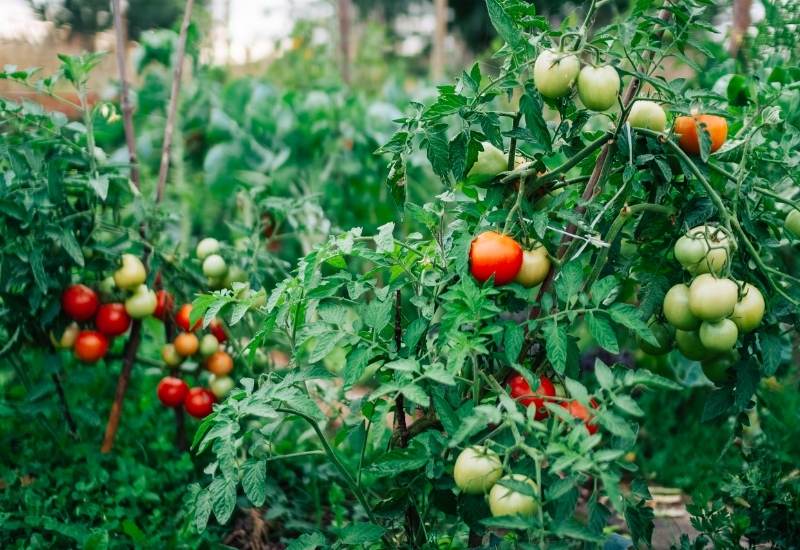
Generally tomatoes ready to harvest 65 – 80 days from the date that you transplant them in the ground. Of course, early producing varieties will be ready earlier, and they are often determinate.
If you don’t know, determinate (bush) tomatoes have a set growth cycle, meaning they reach a predetermined size and will produce only one or two waves of fruit that ripen around the same time.
Indeterminate (vine) tomatoes will grow continuously throughout the season and become extremely tall with staggered fruit production, which ripen throughout the season. Determinate tomatoes typically – but not always- produce fruits early than indeterminate ones.
How do you know when to pick tomatoes?
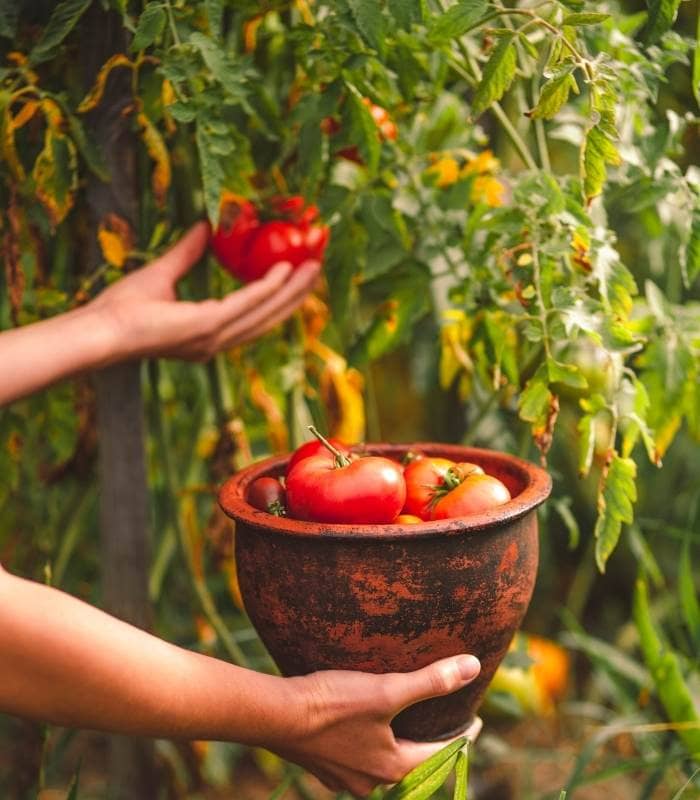
Tomatoes should be harvested when ripe, with a few exceptions that will be explained further below.
Ripening fruits on the vine allows them to receive sugars through the body of the plant for as long as possible and is generally thought to improve their flavor.
Here is a bit more information about the categories mentioned at the beginning of this article which determine tomato ripeness:
What Color Should Tomatoes Be When You Pick Them?
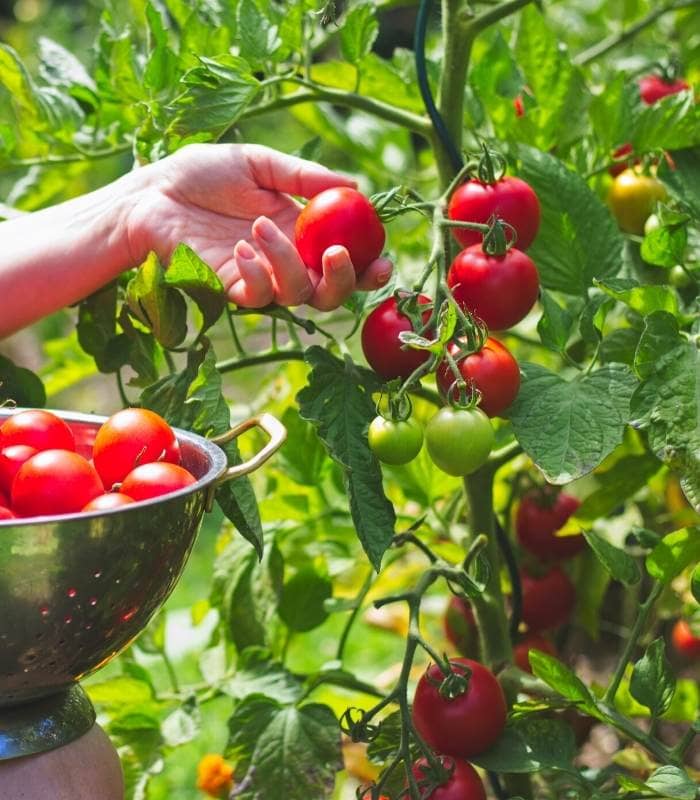
Tomatoes should be harvested when the fruit is a full, rich color. Tomatoes come in many colors: red, yellow, pink, orange, purple, green, and everything in between, so there is no one color they should definitely be.
Unless your variety specifies that the color should be pale, ripe tomatoes will have a deep coloring that is consistent around the fruit.
Many tomatoes will also have patterns like striping (for example the ‘Mr Stripey’ heirloom tomato or the ‘Sunrise Bumblebee’ cherry tomato), and in those cases inconsistent color is, of course, normal.
You can also pick your tomatoes and ripen them off the vine once they reach the “breaker stage”, In this stage they will start changing the green color spell and shows pink or red in color up to 30% of the surface of the fruit.
Shine
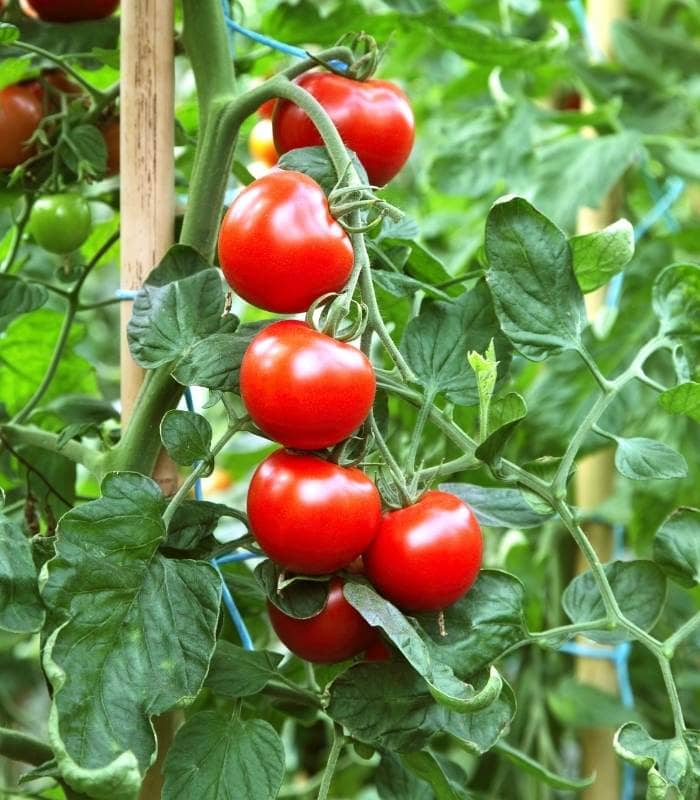
A quick and effective way to tell when your tomatoes are ripe is to check if the fruit has developed a shiny, glossy quality to its skin.
Usually unripe tomatoes will have a slightly dull or matte surface, and you can assess the brightness of the skin against other, obviously unripe fruits on the plant.
If you are growing a new variety and feeling unsure about the color, which can be especially tricky for green or purple varieties, then shine is a good criteria to go by. Shine is even a better criteria to follow than size, which can be deceiving and is therefore not included on this list.
Different tomato varieties have drastically variable sizes, and even within one variety can vary quite a bit, whereas most ripe tomatoes have a shiny skin.
Smell
For many fruits, they will not give off any particular scent when unripe, and their scent reflects the flavor of an unripe fruit which is not particularly noteworthy.
When tomatoes have ripened, they should smell fragrant and delicious! Make sure to place your nose right on the tomato itself, as the branches and leaves of tomato plants also have quite a distinct smell that you don’t want to confuse with that of the fruit!
Consistency
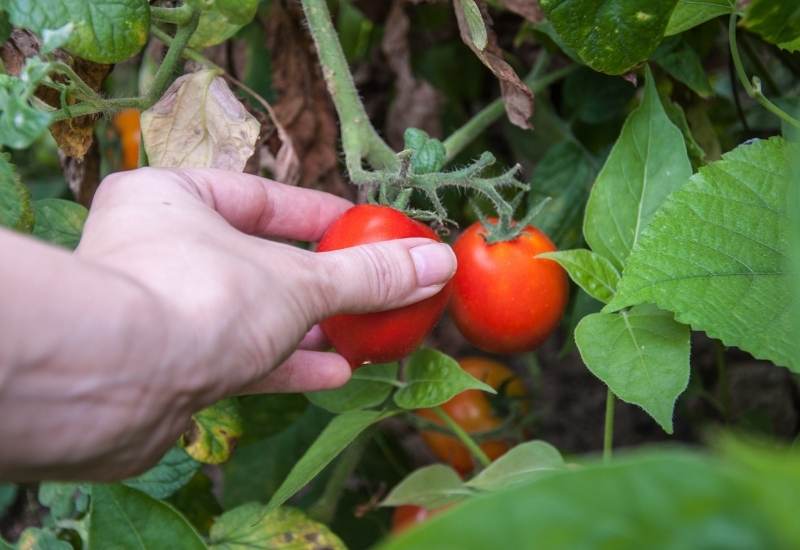
This criteria is a little tricky, since assessing when a tomato is ready to harvest based on how it feels is a skill gained over time. Most farmers and gardeners say that the texture should be somewhere between firm and soft.
Unripe tomatoes are typically very firm, as you may have experienced, and overripe or rotten tomatoes will become extremely soft. When you handle the fruits, be very gentle as they are susceptible to bruising and should not be squeezed.
Instead, lightly grab the tomato between a thumb and forefinger and gently press to feel the consistency. If they are unripe they will have very little to no give at all and should be left on the vine longer.
Although it may seem like a good idea to assess ripeness based off the texture as well, it isn’t all that helpful since different varieties of tomato are anywhere from smooth to downright fuzzy and may not show significant changes in texture during the ripening period.
Ease of removal
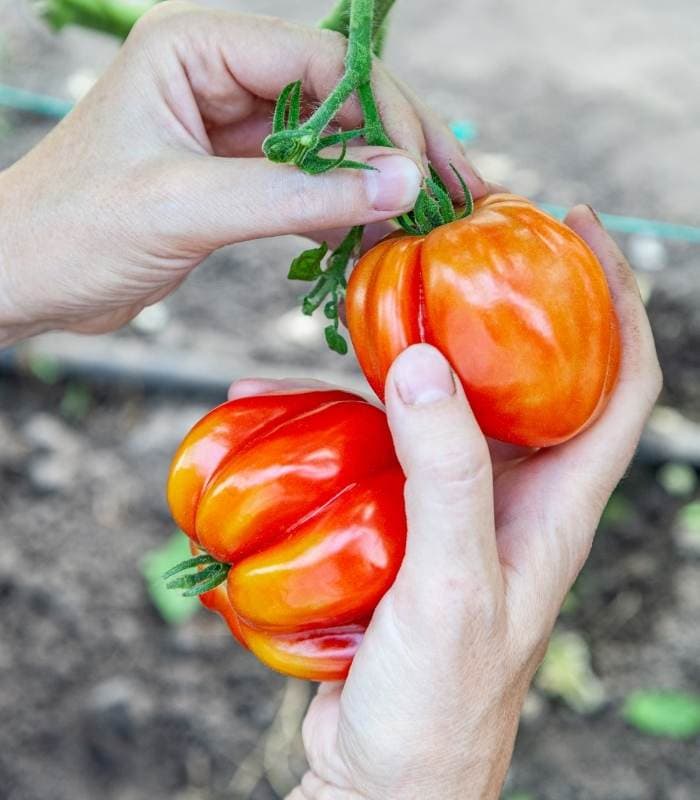
If you have assessed your tomato based on some of the above categories and think they are ready for harvest, go ahead and pluck one off the plant.
The fruit should easily come away from the stem with a light tug, and if you need to pull or yank with any force then they are not ready for harvest.
You can risk damaging the plant or causing other ripe fruits to drop to the ground by pulling hard on unripe fruits, so there is no need to keep yanking if they don’t easily come off themselves.
Tomato Taste
A fully ripe, homegrown tomato will taste truly fantastic! Of course, each variety will have its own distinct flavor and may be slightly more tart or sweet, but you should be able to tell quite quickly if it tastes unripe.
This can actually be the most effective way to assess ripeness, although to avoid wasting fruits you should assess them based on the above criteria first, but it allows you to pick based on your preference.
Some tomatoes are said to be slightly tastier when harvested just before full ripeness, and if that rings true for you then go based on your own tongue!
Special Harvesting Situations
There are some situations where tomatoes should be harvested before they are completely ripe, in which case some of the above advice may be disregarded.
1: When growing heirloom varieties
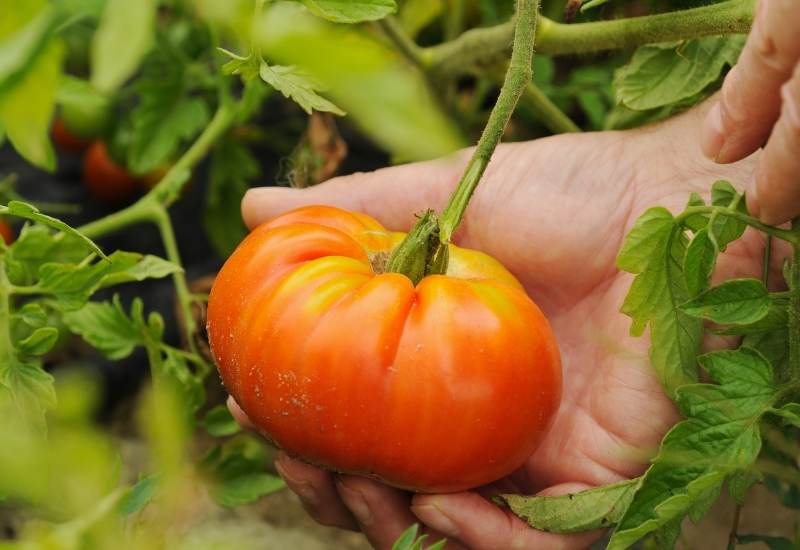
Heirloom varieties are some of the oldest types of tomatoes that have been around for decades. Most of them will actually be ripe just before their color reaches its full depth, so you can pick them just a few days to a week earlier than you might think.
2: When growing some cherry tomato varieties
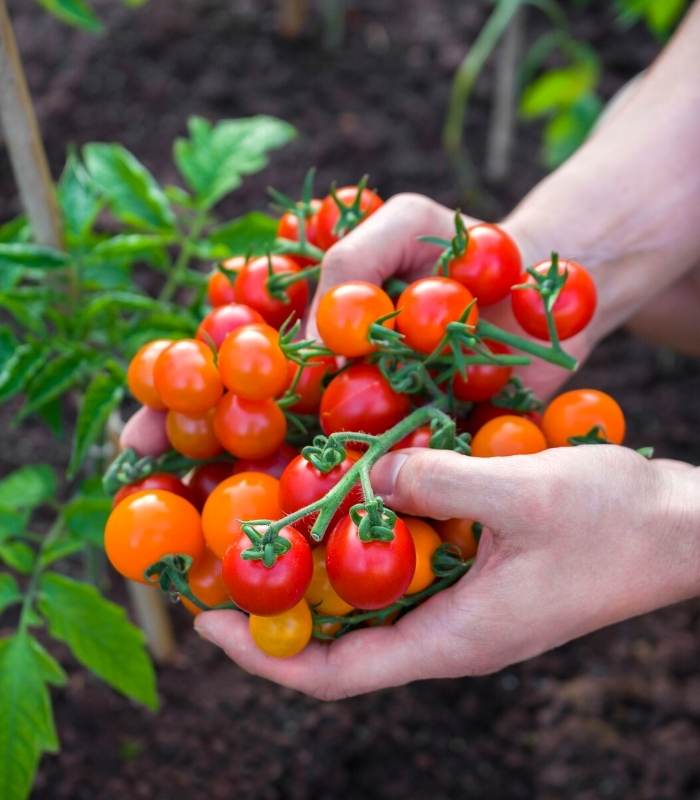
Some cherry tomatoes are more susceptible to splitting or cracking on the vine, and it can be a good idea to harvest them just before they are completely ripe and let them ripen the rest of the way inside. Cut off each branch that is laden with tomatoes and let them ripen indoors on the branch.
3: When a heavy rain event is predicted
If you believe your tomatoes are almost ripe but not completely there yet or when they will reaches the breaker stage, and you see that a rainstorm or a long period of wetness is about to ensue, harvest them before it hits.
This is also to avoid splitting or cracking fruits, which can happen when there is inconsistent soil moisture levels and fruits are suddenly flooded with water, causing them to expand more quickly than the skin creating splits in the fruits.
This can be quite disappointing to experience, especially when you were about to harvest them, so bring them indoors and let the tomatoes ripen off the vine.
How to Harvest Tomatoes
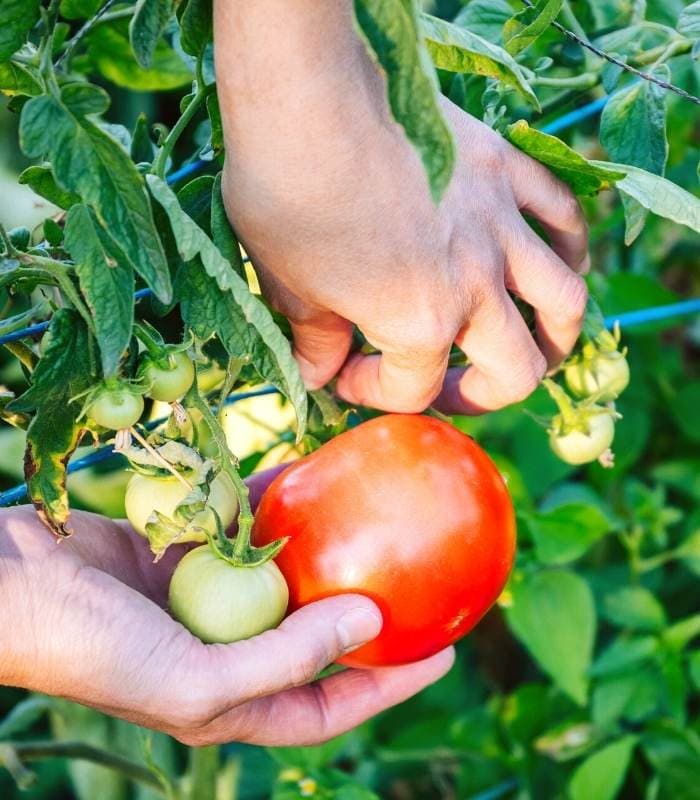
If you are growing indeterminate tomatoes, you will need to return to keep harvesting them continuously a few times a week once they have started producing ripe fruits.
You should monitor your determinate plants closely to assess when their fruits need to be harvested, as it will be a big event with many tomatoes coming in at once.
For both indeterminate and determinate tomatoes, simply hold the fruit and with a slight twist, pull it off the vine. As mentioned above, it should come away easily and is likely unripe if you are struggling to harvest it.
For larger tomatoes like beefsteaks, you might want to use two hands to make sure you don’t drop it! They can be surprisingly heavy.
Ripe tomatoes are very susceptible to being squished and turned into mush, so make sure not to plop a big tomato onto a tiny cherry tomato in your harvesting basket, and don’t overfill it!
If harvesting unripe tomatoes for any reason (some recipes may call for them), use pruning shears to cut away the stem of the fruit and to avoid damaging the plant when pulling it off.
How To Ripen Your Tomatoes Faster On The Vine
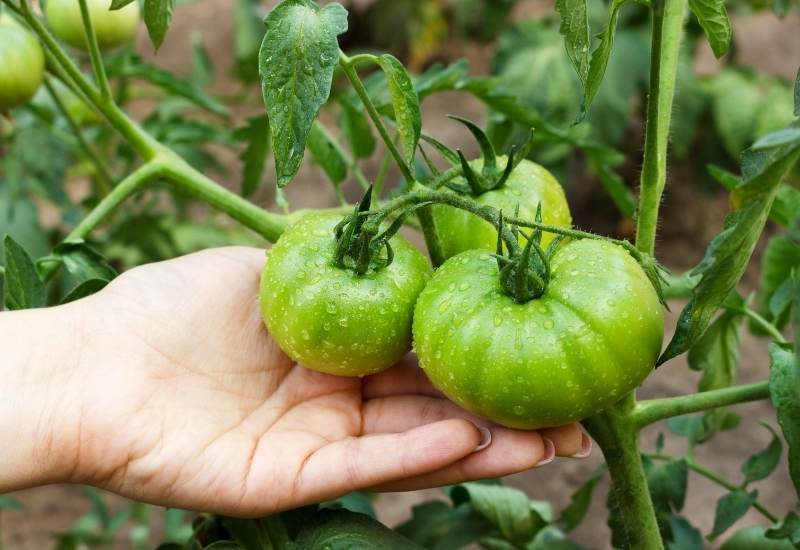
Sometimes you may want your tomatoes to ripen a tad bit faster than they are, especially if you live in a cooler climate that has a shorter growing season.
Here are some things to keep in mind and tips to encourage ripening tomatoes on vines:
Make Sure Plants Are Warm
Temperature controls the ripening process, and temperatures between 65 and 75℉ are ideal for tomatoes to ripen.
Pruning away foliage and exposing fruits to sunlight helps ripen them because direct sunlight will heat up the fruit.
If it is approaching the end of the season and nighttime temperatures are dropping, be sure to cover plants to create a simulated greenhouse effect and create a heat bubble.
Protect Tomatoes From High Heat
If you live in a very hot climate and temperatures are predicted to exceed 90℉, pick your tomatoes beforehand as this high of a temperature may actually stunt your tomato ripening process.
This is mostly based on data available for red pigmented tomatoes, but to be safe you may want to bring all of your tomatoes inside to finish ripening.
Prune Off Growing Tips At The End Of The Season
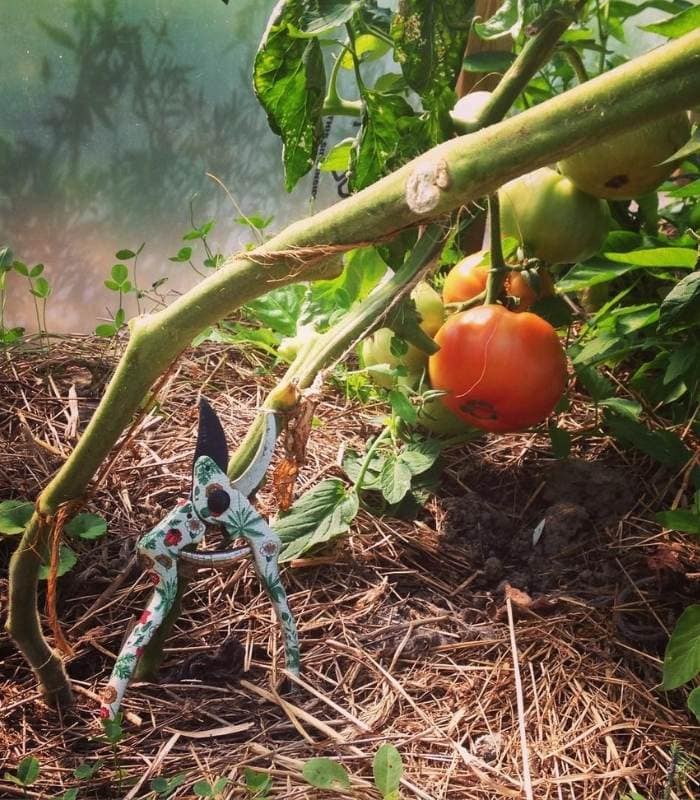
Around 3 to 4 weeks before the first frost, cut off the tops of your tomato plants to speed up the ripening process on the vine.
The top of the plant where new growth is produced is called the growing tip, and one tomato plant may have multiple tips.
Removing them helps the plant to focus all its energy on ripening existing fruits instead of trying to produce and feed new foliage.
Make sure to only do this step for tomatoes once you are sure you do not want any new fruit production!
Watch Out For Fungi On Ripening Fruits
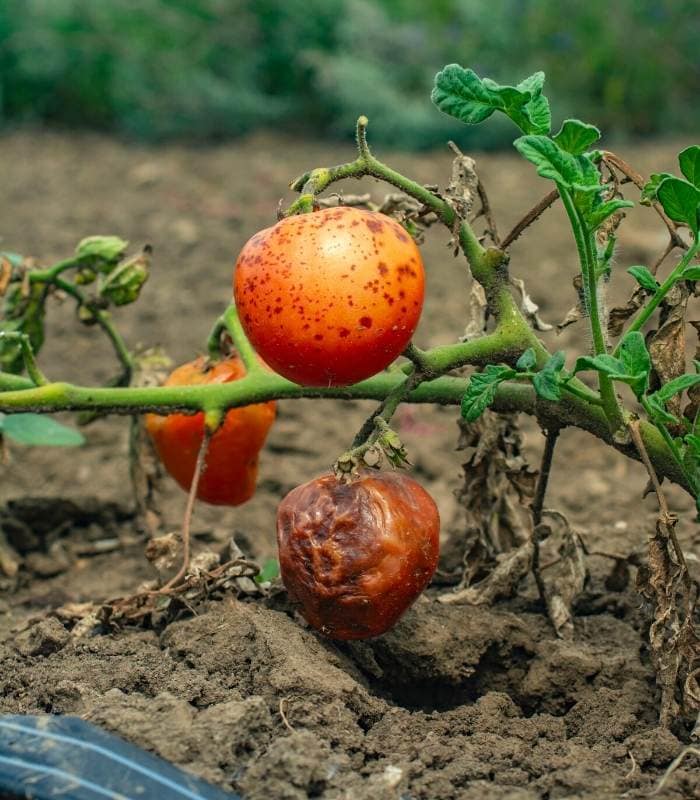
When checking on ripening tomatoes, make sure to watch out for the fungal disease Anthracnose, which typically only shows itself once the fruits are ripening even if the plant was infected earlier in the season.
Sunken black spots will appear on ripening tomatoes, and you should take care to harvest and remove infected fruits quickly, as the spores can spread from fruit to fruit quickly once the sores have developed.
How To Ripen Your Green Tomatoes Off The Vine
Ripen Tomatoes Indoors At Room Temperature
If you had to pick tomatoes before they finished ripening on the vine, make sure to keep them indoors at room temperature, out of direct light, and do not put them in the refrigerator.
If you want them to ripen quickly, put them in a paper or a plastic bag with other ripening fruits. Fruits produce a gas called chemical when ripening, which becomes concentrated in a contained space and will help other fruits ripen quickly.
Harvest Cherry Tomatoes On The Branch
Cherry tomatoes that are picked when unripe can be harvested on the branch and hang them in a fairly climate controlled room, like your kitchen, until they ripen. Any

Written By
Amber Noyes
Amber Noyes was born and raised in a suburban California town, San Mateo. She holds a master’s degree in horticulture from the University of California as well as a BS in Biology from the University of San Francisco. With experience working on an organic farm, water conservation research, farmers’ markets, and plant nursery, she understands what makes plants thrive and how we can better understand the connection between microclimate and plant health. When she’s not on the land, Amber loves informing people of new ideas/things related to gardening, especially organic gardening, houseplants, and growing plants in a small space.
